Diversity and Difference in SHA
 In 2012 the SHA has been active on a number of fronts, and this month I want to examine two of those that I think are exceptionally important to the SHA in the coming years: one revolves around the diversity of the discipline in general and SHA in particular, and the other is the representation of archaeology in popular media. Both are sufficiently complicated to deserve a posting of their own, so this week I take on the former and I will discuss the latter in my next post.
In 2012 the SHA has been active on a number of fronts, and this month I want to examine two of those that I think are exceptionally important to the SHA in the coming years: one revolves around the diversity of the discipline in general and SHA in particular, and the other is the representation of archaeology in popular media. Both are sufficiently complicated to deserve a posting of their own, so this week I take on the former and I will discuss the latter in my next post.
The Questions in “Diversity”
This year I have reported several times on the SHA’s effort to make diversity an increasingly articulate part of the SHA mission and our collective scholarly practice (compare columns on Global Historical Archaeology, Historical Archaeology in Central Europe, and Diversity and Anti-Racism in SHA). There are a cluster of practical questions raised by “diversity”:
- – What does it even mean to be “diverse”? Many of us have become somewhat wary of the term “diversity,” so this demands some concrete definition;
- – Why might we or any other discipline or professional society desire diversity?;
- – What access barriers face various archaeologists and SHA members across lines of difference?;
- – What are the international implications of diversity when we step outside the familiar lines of difference in America?
Many of these questions are to some extent rhetorical in the sense that they have no satisfying answer with utter resolution, but the honest, reflective, and ongoing discussion of all of them is critical. The most recent discussion on these issues came in a Gender and Minority Affairs Committee Panel at the 2013 conference in a session that included Carol McDavid (Community Archaeology Research Institute) and Maria Franklin (Texas) as Chairs, with panelists Whitney Battle-Baptiste (UMass), Chris Fennell (Illinois), Lewis Jones (Indiana), and Michael Nassaney (Western Michigan). They were joined by Richard Benjamin (International Slavery Museum, Liverpool) and Bob Paynter (UMass). Some of the issues are familiar to long-term members, but Board of Directors’ goal is to produce increasing clarity and concrete action. These thoughts are simply my own as an audience member in the session and a Board Member who is committed to an inclusive SHA.
Welcoming Diversity in SHA
The GMAC session revolved around, to paraphrase GMAC Liaison Carol McDavid, making SHA a welcoming environment to a variety of voices. This is perhaps a more difficult thing to measure than mere demography of the membership, because it fundamentally defines diversity as a shared social and emotional sentiment. Nevertheless, it is an absolutely worthy goal that consciously embraces curiosity about and acceptance of people unlike ourselves across time, space, and every conceivable line of difference.
A “welcoming” professional home ensures that colleagues with distinctive experiences and scholarly voices can have significant impact beyond little circles of specialists. We should not underestimate the influence of even a single thoughtful voice, and SHA should be absolutely certain that such a voice feels welcome and supported and can secure a firm and fair foothold in our midst even if we disagree with their scholarly conclusions. I very strongly believe that since the moment a group of 112 people gathered in Dallas in 1967, the SHA has been fundamentally committed to casting itself as a democratic, international scholarly organization, and we have long taken pride in archaeology’s capacity to “give voice” to historical agents who have been overlooked by other scholars. I do not believe that this means SHA is not a “welcoming” professional environment, but some of our members are reluctant to become part of some scholarly discourses or SHA governance, so we need to systematically ask how we can create comfortable places and roles for all our members. Many of the measures to fashion such an environment are apparently modest mechanisms that we can do now, and I have three general thoughts that came out of the GMAC session and broader discussions in Leicester and over the previous year.
Feeling and Being Diverse in SHA
First, I fundamentally agree that in North American historical archaeology in particular the absence of people of color inevitably risks compromising our scholarship. Many of us self-consciously sound the mantra that the meeting seems aesthetically homogenous, which is an inelegant way of saying we are overwhelmingly White and do not appear to reflect society. I am not in disagreement with this observation as much as I hope we can push it to some substantive action. I do not personally think that any scholarly discipline actually “reflects” society in an especially substantive way: that is, scholars gravitate toward the academy, academic production, and particular disciplines because we have specific sorts of creativity, experiences, and personalities. Nevertheless, even within that aesthetic of homogeneity there are a breadth of class, ethnic, international, or queered voices who come to SHA through a rich range of paths, and a vast range of us partner with community constituencies. During the GMAC session Tim Scarlett suggested that it may well be that one thing we need to do is more assertively tell our unacknowledged stories of difference to encourage others that their voices matter in scholarship and SHA governance: that is, being an SHA member is a mechanical act of paying dues, but feeling that we are each an important part of the SHA discussion may be different for our colleagues who feel most marginalized because of race, class, sexuality, age, disabilities, or myriad other factors.
International Diversity
Second, a question sounded in Leicester was what constitutes diversity as we move beyond the confines of North America? As we grow and become a truly international, wired organization connected across increasingly complicated lines of space and difference, SHA needs to assertively work to advocate for all our members and the diverse worlds in which we all live. Our international membership provides a rich way to confront Americans’ distinctive experiences of lines of difference, so I hope we will cast diversity in the most complex social, historical, and international terms that are compelling to all our members and make all of us feel welcome in SHA. We are an international organization in a transnational moment in which many of us are increasingly threatened by the decline of jobs in the private sector, agencies, and the academy alike, and for many of us SHA provides a refuge and a voice for our collective scholarship. We must always assertively and self-critically assess shifting lines of difference, so I do not believe what we call diversity will ever settle into a few neat categories.
Diversity as Good Scholarship
Third, like all scholars, we will continue to have standards of scholarly rigor we are all held to regardless of our demography or identity. Some of our work will always be somewhat particularistic and descriptive, and not every project or research context needs to be focused on inequality or public engagement: lots of us need to do the fine-grained artifact and documentary research that makes historical archaeology so compelling in the first place. Respect for scholarly rigor and difference alike breeds civility and personal humility that encourages talent and makes for good scholarship: multiple and often-dissentious voices constantly destabilize normative methods and narratives, while homogeneity simply reproduces itself and is at best boring scholarship and at worst socially reactionary. It is absolutely true that we are all part of employment and educational contexts that have a variety of structural inequalities that risk yielding social and intellectual homogeneity. We should be prepared to acknowledge when some standards hinder our colleagues, and in SHA I think this means always pressing to be transparent, respectful, encouraging, and clear about the scholarship, service, and communication done in our collective name. We remain committed to diversity simply because a welcoming and creative intellectual environment produces the best scholarship.
Diversity as an SHA Value
Will SHA resolve all those questions I posed at the outset of this blog? Of course we cannot resolve structural inequalities that took a half-millennium to develop and now have a rich range of international faces. SHA is one professional organization, and while we advocate for a rich range of scholars and our members touch the lives of countless people beyond our membership, our mission remains focused on encouraging the scholarly study of the last half-millennium. Nevertheless, in recent years the Board of Directors has undergone diversity training, a Gender and Minority Affairs Travel Scholarship has been created, and we have begun to examine the concrete ways we can invest the organization from top to bottom with an embrace of difference. Now we need every SHA Committee to ask itself what its stake is in this discussion on diversity: If these moves are going to create genuine change in SHA, then diversity needs to be on the agenda for all committees and not simply the GMAC.
At the 1968 SHA meeting in Williamsburg, Kathleen Gilmore, Dessamae Lorrain, and Judy Jelks were among a very small number of women at the conference, which apparently included no people of color at all. Today our membership is nearly evenly split between men and women and our Presidents have included 12 women, including 11 of the last 24 Presidents. We continue to work to ensure that we are the best possible advocates for all our members because we carry an important role, and we should never underestimate the many lives each of us profoundly touch, sometimes without even knowing it. While we will not resolve the inequalities that hinder access to the academy or scholarship, we can place these issues in discussion, embrace them as our core values, and persistently press to be a good example of inclusion, respect, and acceptance. I truly believe SHA members have always been committed to a truly democratic scholarship, and I think in many ways we are simply continuing to articulate the values of many scholars before us. It is important to keep articulating those values and doing all we can to move this discussion to the heart of SHA’s culture.
Archaeology Education Clearinghouse and the National Council for the Social Studies Conference, Seattle, WA
Under the collaborative umbrella of the Archaeology Education Clearinghouse (AEC), representatives from the Society for Historical Archaeology (SHA), Society for American Archaeology (SAA), and Archaeological Institute of America (AIA), came together at the National Council for the Social Studies (NCSS) conference to share archaeology education resources with social studies educators from around the nation. NCSS is a national organization for all sorts of educators concerned with social studies, including classroom teachers, administrators, college and university educators, and those who specialize in curriculum and policy.
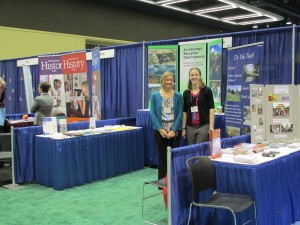
Christy Pritchard and Meredith Langlitz prepare the Archaeology Education Clearinghouse booth. Image courtesy of Christy Pritchard.
Over the course of two November days in Seattle, over 300 people stopped by the AEC vendor booth. Over half of the folks who stopped by the AEC booth engaged in conversations with Meredith Langlitz, Christy Pritchard, or Mary Petrich-Guy. These archaeologists spoke with educators, shared information, and, demonstrated the engaging utility of archaeology as a tool for meeting curriculum requirements. In addition to the vendor booth, Pritchard, assisted by Langlitz, led a session for 35 classroom teachers, “Archaeology and Social Studies: Making the past come alive in your classroom!”
The range of archaeology lesson plans available through AEC impressed conference attendees. Many Washington teachers were familiar with the state organizations listed on a state resource flyer, such as the Burke Museum, but were unacquainted with the abundance of teaching resources accessible through the AEC. Even educators weighed down by the barrage of promotional materials enthusiastically picked up the “ultralight” AEC flyer to take home and access the web of archaeology teaching materials.
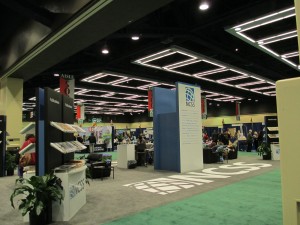
The AEC booth was handily located near the NCSS information and rest area in the vendor’s hall. Image courtesy of Christy Pritchard.
Educators can then use the materials from the SHA, SAA, and AIA in classrooms and interpretive settings to meet national and state curriculum standards. In its fifth year, the AEC provides a point of access to all three organizations’ K-12 education materials ranging in focus from what is archaeology, prehistoric, historic, and classical archaeology, to careers in archaeology. A range of lesson plans compiled by the three organizations cover the ten themes of social studies in national curriculum:
1. Culture
2. Time, continuity, and change
3. People, places, and environments
4. Individual development and identity
5. Individuals, groups, and institutions
6. Power, authority, and governance
7. Production, distribution, and consumption
8. Science, technology, and society
9. Global Connections
10. Civic ideals and practices
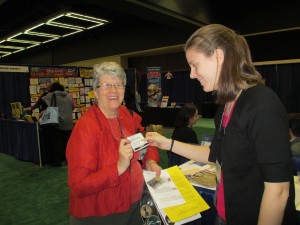
Meredith Langlitz shares a sticker with an archaeology educator. Image courtesy of Christy Pritchard.
Though the utility of archaeology as a social studies teaching tool may be clear to archaeologists, and some teachers are big fans, many conference attendees asked questions like, “I teach U.S. History, how does that relate to archaeology?” Luckily, representatives from each society were able to connect with teachers across the broad spectrum of social studies topics and had example lesson plans on hand. To reinforce the idea that social studies teachers already use archaeological information in the classroom, AEC representatives passed out “I Teach Archaeology” stickers. Designed for conference nametags, these handy visuals are also potential conversation-starters beyond the vendor’s booth.
Overall, the attendance of the AEC at the NCSS conference was a success. Archaeologists engaged in hundreds of conversations with educators and armed them with great a great point of contact to access hundreds of educational resources. It was a pleasure to connect with so many fabulous educators. Next year’s NCSS conference is in St. Louis and attendance is expected to be even greater!
References
National Council for Social Studies
2012 National Curriculum Standards for Social Studies: Chapter 2 – The Themes of Social Studies. National Council for Social Studies, Silver Spring, MD. <http://www.socialstudies.org/standards/strands> Accessed 10 December.
If You’re a Student in Leicester!
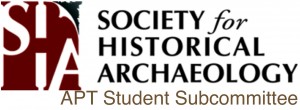 Every SHA annual conference has programming of interest to and specifically geared towards students. Leicester will be no different. Here are some of the coming conference offerings students might want to highlight.
Every SHA annual conference has programming of interest to and specifically geared towards students. Leicester will be no different. Here are some of the coming conference offerings students might want to highlight.
Globalisation, Immigration, Transformation: the 2013 Plenary Session
(Wednesday January 9th 6-8pm)
Students arriving in Leicester for the opening day of the conference will find the Plenary Session a place where SHA membership comes together across research interests and affiliations. The session panel will focus on case studies and moderators will facilitate a broad exploration of the conference themes.
Navigating the Field: Education and Employment in a Changing Job Market
(Thursday January 10th 8:30-10:30)
Cosponsored by the APTC Student Subcommittee and ACUA, this session is Part I of II and will focus specifically on student concerns. Panelists from both underwater and terrestrial backgrounds will address what is arguably the most pressing issue on many students’ minds—jobs. Whether you seek a job in the United States, Europe or elsewhere, panelists will offer their perspective on how education matches up with the changing job market.
Past Presidents’ Student Reception
(Thursday, January 10th, 4:30pm- 6:00pm)
Students are invited to join SHA past presidents for an informal reception. This is a great opportunity to connect with leaders in the organization. A free drink and snacks will be provided.
Equity (Issues) for All, Historical Archaeology as a Profession in the 21st Century
(Friday January 11th 9-12:30)
Part II of these sessions on professional issues, this symposium will address concerns of gumptious academic and cultural resource management archaeologists. Senior managers and tenured professors from across the US and UK comprise the panel. This will be an opportunity to engage upper management and tenured faculty in discussions of how to address current equity issues in the workplace, the barriers they faced rising in the ranks, and how they got to where they are today.
SHA Business Meeting
(Friday January 11th 5-6pm)
The SHA Business Meeting will be open to all members, students included. The organization welcomes and encourages student participation.
Academic and Professional Training Committee (APTC) Student Subcommittee (SSC) Meeting
(Saturday January 12th 12:30-1:30)
The Academic and Professional Training Committee’s Student Subcommittee is run by and focused on SHA student members. As a formal platform for the interests and voices of students, it is a great way for them to contribute, develop professional skills and increase visibility. The SSC provides opportunities for students to participate in the organization at a variety of commitment levels. Committee members organize sessions, are student liaisons to other committees, and contribute to the blog and newsletter. During the meeting, students will learn about ongoing activities and have the chance to get involved. Students participating in the SSC drive activities for the upcoming year and develop new projects. (Please note the midday time slot.)
Rap Session for Student Members
(Saturday January 12 1:30-5pm)
Sponsored by the Student Subcommittee, the informal format of the RAP session will allow students to hang out and discuss issues of import to them. Panelists are archaeologists at all stages in their career, both underwater and terrestrial. The popularity of this session grows each year and will be a great way to sum up any conference experience.
If you are a student attending the annual meeting in Leicester, please email the SSC chair, Jenna Coplin. If you cannot attend the committee meeting, but are interested in learning more about the SSC or keeping up with SSC goings-on throughout the year, email Jenna to be added to the student list serv. Also, be sure to follow the hashtag #SSC on Twitter throughout the conference (along with the #SHA2013 tag!) for student-specific tweets and messages!
In addition to these sessions, check out Emma Dwyer’s blog post about trips and tours of Leicester offered through the SHA.
SHA 2013: Easy Trips from Leicester
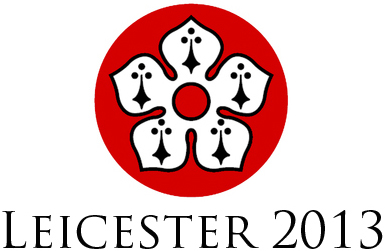 With just over two weeks to go, the team in Leicester is busy putting the finishing touches to the conference (with perhaps a short break to consume Christmas pudding, and sit down for the Downton Abbey Christmas Special).
With just over two weeks to go, the team in Leicester is busy putting the finishing touches to the conference (with perhaps a short break to consume Christmas pudding, and sit down for the Downton Abbey Christmas Special).
You can find all the information you need to complete last-minute travel and accommodation arrangements on the conference website, where Local Arrangements Chair Ruth Young has compiled a list of easy trips you can make from Leicester, if you fancy a day out.
Pre-registration for the conference has now closed, but you can still register on the day, by coming along to the Percy Gee building at the University of Leicester campus, where all delegates should also collect their conference packs and name badges.

The Percy Gee Building, home to the Leicester University Students Union, and SHA 2013 registration area
If you do have any questions or problems, please send us an email at sha2013leicester@gmail.com
Legislation to Protect the Titanic Moves Forward
The Society for Historical Archaeology (SHA), with the assistance of Cultural Heritage Partners, PLLC (CHP), is leading the charge for legislation to protect the Titanic wreck to become law, and we hope it will be passed during the upcoming lame duck session of Congress.
In March 2012, Sen. John Kerry (D-Mass.) introduced legislation co-sponsored by Sen. Johnny Isakson (R-Georgia) known as S.2279, the “R.M.S. Titanic Maritime Memorial Preservation Act of 2012” (the Act). The Act is intended amend a 1986 law to provide additional protection for the Titanic and its wreck site, and the Act’s passage will help minimize harm from activities directed at the wreck (such as salvage, research, and tours). Right now, both natural causes and human activities are damaging the Titanic site. Little can be done to prevent the natural aging and corrosion of the wreck site, but the Act can help prevent further physical deterioration caused by tour groups and underwater vehicles. The Act aims to protect the site’s archeological integrity and to ensure that it is treated as a maritime memorial for the 1,500 people who perished when it sank. So far, the Act has been well received by the Senate.
On March 29, 2012, the Act was referred to the Committee on Commerce, Science, and Transportation, and on July 31, 2012, the Committee ordered the Act to be favorably reported without amendment. This means that, with virtually no debate over the merits of the bill, the Committee approved of the Act as it was written and suggested that it move forward to become an approved law. On behalf of SHA, CHP has been actively meeting with Senate staffers on Capitol Hill to promote the purpose of the Act, with the goal of getting it passed with unanimous consent during Congress’s quickly approaching lame duck session. To assist with this goal, CHP has drafted summaries of the legislation to provide to staffers to educate them about the purpose and nuances of the Act. CHP has also been coordinating with other interested groups to garner support for the Act in the House of Representatives. If all goes well, S.2279 will provide protection for the R.M.S. Titanic and its wreck site for many years to come.
Defining a Global Historical Archaeology
 Every historical archaeologist has at some point defined the discipline to the visitors at an archaeological site, a roomful of students, or a colleague or community member. Most of us have a pretty clear notion of what distinguishes historical archaeology, and while it may diverge from what our teachers once told us, the conventional definitions in reference sources, or even the SHA’s own definition, we do seem to return to some consistent elements: for instance, material things always seem to lie at the heart of what we do; most of us see ourselves as multidisciplinary scholars; we value rigor and replicability (even if we entertain sophisticated theory or are sometimes wary of being labeled a “science”); and we focus on peoples living in the last half-millennium or thereabouts.
Every historical archaeologist has at some point defined the discipline to the visitors at an archaeological site, a roomful of students, or a colleague or community member. Most of us have a pretty clear notion of what distinguishes historical archaeology, and while it may diverge from what our teachers once told us, the conventional definitions in reference sources, or even the SHA’s own definition, we do seem to return to some consistent elements: for instance, material things always seem to lie at the heart of what we do; most of us see ourselves as multidisciplinary scholars; we value rigor and replicability (even if we entertain sophisticated theory or are sometimes wary of being labeled a “science”); and we focus on peoples living in the last half-millennium or thereabouts.
Nevertheless, it is still completely reasonable that we have some distinctive visions of precisely what constitutes historical archaeology (or should define it) (compare the historical archaeology course syllabi definitions at the SHA Syllabi Clearinghouse). The discussion over what defines historical archaeology has roots reaching over more than a half-century, and the dynamism of the discussion over our field is a good indication of historical archaeology’s dynamism and growth. As the field now stretches its chronological boundaries into the contemporary world, encompasses an increasingly broad range of intellectual traditions, and pushes its geographic horizons to every reach of the planet, that discussion may be as lively as it was in the 1960s. The SHA does not need to impose a definition of the discipline onto everybody digging something we might call historical archaeology, and in fact the discussion of the rich range of historical archaeologies is more important than forging a universal definition of the discipline that encompasses every time and place. Instead, we need to continue to promote a rich discussion that reaches across global divisions, lines of historical difference and contemporary inequality, and moments in time.
The differences in conventional definitions of historical archaeology are perhaps most apparent outside the confines of North America. As we prepare for our annual conference in Leicester in January, 2013 and then Quebec a year later, it is increasingly evident that what North Americans call historical archaeology goes by a variety of labels in Europe, Africa, South America, or the Pacific World: post-medieval, modern, and contemporary archaeologies all describe some scholarship akin to American historical archaeology. Historical archaeology emerged at roughly the same moments in North America, the UK (with the Society for Post-Medieval Archaeology’s formation in 1966), and Australia (the Australasian Society for Historical Archaeology was founded in 1970). All of these scholarly traditions push the conventional North American framing of historical archaeology in productive and exciting ways.
The most influential definitions of North American historical archaeology tend to revolve around the cultural transformations associated with Anglo and European colonization. However, that definition looks out at the globe from the New World and has often somewhat ironically not examined the very European and African societies sending peoples to the New World. For our European colleagues doing archaeologies of the last 500 years, the transformation into a post-medieval world reaches well into the medieval period and reveals dramatic variation from the Iberian Peninsula into central and northern Europe. Pictures of Africa and Asia likewise have a historical depth that is not easily accommodated to a narrowly defined focus on European colonization alone.
Many historical archaeologists have focused on the ways in which emergent capitalism and colonization transformed the planet and provide an intellectual framework for historical archaeology. Yet that sprawling profit economy was never utterly homogenous and integrated despite its global scale. Capitalist penetration into New World colonies, Africa, and the breadth of Europe itself was inevitably variable across time and space, and archaeologists have particularly rich data to dissect the contextually distinctive spread of capitalism and local experiences of capitalist transformations.
The rapid growth of contemporary archaeology encompasses a breadth of research subjects that likewise stretches our conventional notion of historical archaeology. William Rathje’s garbology studies laid much of the foundation for archaeologies of the recent past and contemporary world, and Americans have conducted a variety of modern material culture studies since the 1970’s taking aim on everything from electric cars to pathways of migration to wartime detention centers. Archaeologies of the present-day world have been exceptionally active in the UK and Europe, where contemporary archaeologists have conducted creative, thoughtful, and challenging research on everything from wartime landscapes and prison camps (in Finnish, but video images) to Cold War materiality to punk graffiti. For many of us this scholarship is intimately linked to historical archaeologies that have focused on more distant pasts and should have a clear role in a global historical archaeology that reaches firmly into the present.
The transformation to an increasingly global historical archaeology may be bearing the fruit envisioned by the very first historical archaeologists, whose January, 1966 gathering at Southern Methodist University was dubbed the “International Conference on Historic Archaeology” (my italics). In 1968, SHA President Ed Jelks (1968:3) intoned that “Historical archaeology has much to gain in the long run from encouraging a spirit of concerted, interdisciplinary, international cooperation.” Many of our colleagues in the nearly 50 years since the Texas conference have been committed to a historical archaeology that always thinks of global systemic relationships beyond our local sites, but we are especially fortunate to live in a moment in which there is a rich international scholarship of the last half millennium that is increasingly accessible thanks to digitization.
Indeed, that global historical archaeology may well be SHA’s next horizon for growth in terms of both the society’s literal membership numbers and the discipline’s more significant expansion as a scholarly voice throughout the world. Historical and post-medieval archaeologists are researching nearly every corner of the world and bring rich scholarly traditions distinct from North American anthropology. That global historical archaeology is profoundly shaped by the concrete connections made possible through online scholarship and communication across a wired planet, and it bears significant debts to the SHA’s own commitment to conduct international conferences.
The Society for Historical Archaeology is only one steward for this rich international scholarship, and that scholarship is inevitably richer for including a broad range of global archaeological methods, scholars, and approaches. International historical archaeology provides increasingly rich possibilities for the scholarly growth of historical archaeology that is increasingly globalized, compelling, and intellectually rigorous.
Jelks, Edward B.
1968 President’s Page: Observations on the Scope of Historical Archaeology. Historical Archaeology 2:1-3.
Archaeologists Anonymous at SHA 2013
‘What are your hopes and fears for the future of archaeology?’
The Archaeologists Anonymous team are coming to the SHA conference and will be holding a panel session on the morning of Friday 11th January. In the run-up to the conference we’d like to invite all SHA delegates to send us your hopes and fears on a postcard and make the panel session a success!
How to get involved
The process is a simple one. You need to find a postcard, adapt its front cover somehow, and write your message (anonymously) on the back, and then post it to the address on the Arch Anon blog
Your postcard will join the other postcards we’ve received and will be prominently displayed on the blog – these postcards will form the basis for discussion points during the SHA panel. Your postcard could therefore lead vibrant debate regarding the future of archaeology during the 21st century at SHA: an important, international conference.
Why postcards?
We want to slow down the immediacy of digital communication and through regressive creativity provide an alternative to the fast-paced and hyper-identified world of Twitter, Facebook and email. We want to provide an opportunity for you to make something and use hand-writing rather than create through the technology of a laptop. Joining in will take a little time. You’ll need to find the ‘right’ postcard, think of your message and post it to us but we hope you’ll agree that the method is worth it. The postcards we’ve received are individual, striking and thought-provoking.
Postcards in archaeology
We also recognise the growing interest in postcards within the archaeological community. Sian Jones’ recent paper at CHAT in York considered the ways in which postcards from Whitworth Park in Manchester operated ‘as material objects’ whether ‘mass-produced, commoditized, personalised, exchanged and consumed’.
Why anonymity?
We are asking for contributors to send postcards anonymously as we want the message on the postcard to be more important than who is saying it. We are hoping that anonymity will allow the voices of undergraduates to be undifferentiated from the voices of professors. We are interested in all voices: whoever you are we would like you to send us your hopes and fears postcard.
The panel at SHA
The majority of places on the SHA panel will be filled on the day by members of the audience. It could be you! Joining the panel are Natasha Mehler (University of Vienna); Sara Perry (University of York); Sefryn Penrose (Atkins Heritage/University of Oxford); Sarah May (Independent); Emma Dwyer (University of Leicester); Katrina Foxton (University of York) and James Dixon (Archaeologists Anonymous).
The panel will draw on the postcards we’ve received to discuss the future direction of the discipline, the Arch Anon project, and the interconnections between anonymity and academia.
We are pleased that Katrina Foxton will be joining the SHA panel. Katrina’s recent work has focused on a specific collection of Victorian photographic postcards produced by Francis Frith (1822-1898), who took up the task of photographing every landscape and landmark in England during the 1860s. Looking at his work both in physical form and on the internet, Katrina’s work on postcards has considered how both the discursive aspects of the image content (including the achievement of a standardised way of obtaining that ‘perfect shot’, which is dependent on the material form and commercial success of the postcard) can lead to an understanding of postcard ‘culture’ and heritage today. Moreover, the prolific use of postcards in their hey-day has been likened to an early form of twitter (Staff 1979, Woody 1998, Procheska and Mendelson 2010).
Therefore, she is interested in the more recent mobilisation of these multi-dimensional photo-objects (Edwards and Harts 2004, Gillen and Hall 2011) within this particular archaeological debate, as it points to a further evolution in the postcard’s cultural life and its status as a epistolary medium.
We’re looking forward to hearing what Katrina has to say about Archaeologists Anonymous!
Can I bring a postcard along on the day?
We’d love you to be involved but we really want to have a stamp on the postcard so we can tell which countries the postcards have come from. And we really don’t want to know who’s made them. So please do post yours in time for SHA.
Any questions?
Send us an email – archaeologistsanonymous@gmail.com
See you in Leicester!
Hilary Orange, James Dixon, Stacey Hickling and Paul Graves-Brown (The Arch Anon team)
Navigating the Field: Education and Employment in a Changing Job Market
This year the Student Subcommittee of the Academic and Professional Training Committee (APTC) and the Advisory Council on Underwater Archaeology (ACUA) Student Council are cosponsoring a forum dedicated to helping students navigate the current job market in archaeology. Thanks to the efforts of my co-organizer, Barry Bleichner, the forum will host six engaging panelists, and it will be held on Thursday, January 10, 2013. For location, time and a list of panelists, click here.
The global economic downturn has shifted government funding priorities away from cultural and historic resource preservation, and jobs have been lost. However, the enthusiasm and dedication of archaeologists across the world has allowed public programming and archaeology education initiatives to grow with exceptional speed and direction (see list of organizations at the bottom of this blog).

Image from the Archaeological Institute of America’s website for the second annual National Archaeology Day [NAD] held on October 20, 2012; each blue marker represents a separate event organized in honor of the day (image courtesy of American Anthropological Association).
I conducted a small informal survey to gain a better understanding of student perspectives about the current job market. According to the results, the insecurities that archaeology students have about the pressure to find work in a depressed economy are abundant, but with a network of support, students will find jobs! Remember, the insights to follow serve only as an introduction; the forum in January will host several professionals who are prepared to tackle these topics in-depth.
“Volunteer, Volunteer, Volunteer!”
Fewer paid positions at archaeological venues has meant an increase in the skill requirements of new hires as well as an increase in the amount and type of work produced by volunteers and interns. The anxiety of making yourself the ideal candidate for a job can seem overwhelming, but it is important to stay calm and work on acquiring new, resume-bolstering skills.
I asked respondents of my survey, “Beyond acing exams and essays, what can students do to prepare themselves to be great candidates for jobs in archaeology?” The overwhelming answer from students and professionals, alike? VOLUNTEER. One participant responded with fervor, “Volunteer, volunteer, volunteer! Entry level jobs can be hard to come by for students looking to gain experience. Volunteering allows you to not only fill up your CV and gain skills, but also make professional connections that could help you land that job.”
Employers are looking for people who are able to engage the community and solve problems with creativity and innovation. Volunteering can help you practice your skills while showing potential employers what you have to offer.
As a graduate student at the University of South Florida’s Applied Anthropology program, Becky O’Sullivan began her career by volunteering with Florida Public Archaeology Network (FPAN). Soon, this volunteer position became a paid graduate assistantship. This experience gave O’Sullivan an opportunity to practice what might not have seemed natural to her, “Presenting at a professional conference can be nerve-wracking, I’m naturally adverse to getting up to talk in front of large groups, but the benefits of sharing your work with others and in turn learning from their work far outweigh those drawbacks. A good presentation can make you rethink even your most basic assumptions about what archaeology is and should be and make you a stronger researcher as a result!” This excerpt, written by Ms. O’Sullivan in January 2012, is taken from FPAN West Central Region’s blog. Ms. O’Sullivan is now the outreach coordinator for FPAN’s West Central Region office.
Flexibility can be useful when you are looking for a paid job, but whether you are in a small town or a big city, there is a cultural organization willing to train you as a volunteer. Start by donating two hours a week; this allows you to keep your “after-college bill-paying job” while you start to build professional connections in your field. Once your schedule opens up, you can invest more time in a project to which you already contribute.
Keep an Open Mind
In response to my questionnaire, one student reports about her experience using her degree outside of archaeology, “As far as alternate job routes go, I am looking at teaching positions from a wide range of disciplines. I find that my type of scholarship will probably fit in better in an American Studies department, so I am looking at jobs in American Studies, history, and American Indian studies departments along with anthropology.”
Try reexamining your own career goals and consider different ways to use your educational background in archaeology. This exercise invites you to think about ways to make archaeology skills useful to employers outside the discipline. See the list at the bottom of this blog for ideas about where to find jobs.
When you are working on your CV or preparing for an interview, mention your special skills. Sometimes your “hobbies” (theater, photography, painting, archery, singing, film-making, poetry, basketball, etc.) can be a great asset to employers. Many successful archaeologists and anthropologists use such hobbies to enhance their projects and outreach programs.
The following excerpt comes from a book edited by John H. Jameson Jr. and Sherene Baugher called Past Meets Present: Archaeologists Partnering with Museum Curators, Teachers, and Community Groups,“In the face of an increasing public interest and demand for information, archaeologists are collaborating with historians, educators, interpreters, museum curators, exhibit designers, landscape architects, and other cultural resource specialists to devise the best strategies for translating an explosion of archaeological information for the public.” This book (and many others) provides examples of how archaeologists collaborate with people from other disciplines or work within other disciplines to help protect and share the cultural resources of our nation.
Communicate, Stay Involved and Believe in Yourself
Consider how large your support network is when you are looking for work. University students have many resources, but as a professor once told me, “Your most valuable tool is the connections you make with the people around you.” When you graduate, many other students will be at your side, and it is invaluable to keep in touch with friends and colleagues who may one day be able to help you land a new job.
You can acquaint yourself with people who are working as professionals in archaeology by attending and presenting at conferences. I am amazed by the kindness of professors and other professionals who I have met at various conferences. Reaching out to the people I admire has given me the confidence to continue working towards my goal of being a paid employee in the field. Social-networking sites like LinkedIn, Academia.edu, or Facebook can be great tools for keeping up with people you have met.
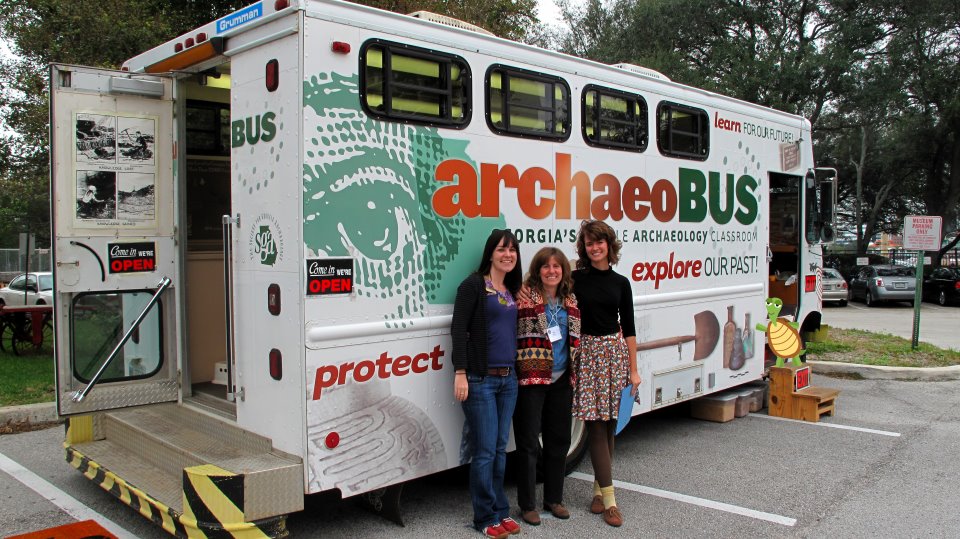
Becky O’Sullivan, Rita Elliott, and Roz Crews (author) at SEAC (South Eastern Archaeology Conference) Public Day 2011; thanks to Jeff Moates, director at FPAN WC, for taking the photo
I met Becky O’Sullivan and Rita Elliott as an intern working on my undergraduate honors thesis about archaeology education and outreach. Talking with them gave me the courage to present my ideas to a wider audience. Rita Elliott and her team from the Society for Georgia Archaeology created ArchaeoBUS, a mobile learning classroom, and they have since shared Georgia archaeology with people across the state.
If you would like to reach me directly, my e-mail is rozalyn.crews@ncf.edu.
Archaeology outreach programs:
Project Archaeology, Florida Public Archaeology Network, Arkansas Archaeological Survey, Crow Canyon Archaeological Center, Northwest Cultural Resources Institute, Hawai`i Junior Archaeology Outreach Program
Job opportunities:
National Park Service, the U.S. Forest Service, the Bureau of Land Management, the U.S. Fish and Wildlife Service, your local Sate Historic Preservation Office (SHIPO) or Tribal Historic Preservation Office (THIPO), a local museum or visitor center, a local university lab or ethnography department, or a state archaeology or history society. Don’t forget to check USAJobs for archaeology jobs around the country.
Works Cited
- Jameson, John H. and Sherene Baugher (eds.)
- 2007 Past Meets Present: Archaeologists Partnering with Museum Curators, Teachers and Community Groups. Springer.
SHA 2013: Leicester’s Pubs
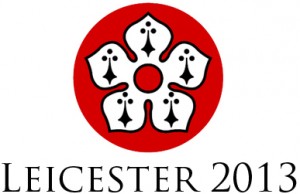 Early registration closes on Monday 3rd December, so you have only one week left to register for SHA 2013 before fees increase. Conference pre-registration will close on 21st December. Members of the Society for Historical Archaeology or Society for Post-Medieval Archaeology get a substantial discount on the registration fee, so don’t delay!
Early registration closes on Monday 3rd December, so you have only one week left to register for SHA 2013 before fees increase. Conference pre-registration will close on 21st December. Members of the Society for Historical Archaeology or Society for Post-Medieval Archaeology get a substantial discount on the registration fee, so don’t delay!
Don’t forget to book your accommodation; there are still rooms available in the four conference hotels, as well as other budget options in the city. And don’t forget to arrange your travel either. The conference committee has negotiated a special offer for delegates travelling up from London by train, and there are many other bargain train travel options for those who book in advance.
In the meantime, and as the cold winter nights are drawing in, our attention has turned to the cosy warmth and hospitality of Leicester’s pubs. The city has a great range, from continental-style cafe-bars to homely inns, all serving a wide range of drinks and food. Some of our favourites are on this map.
The East Midlands boasts a number of craft breweries, producing ales for sale in the city’s pubs. Everards is a major employer in Leicester, and most of the city’s pubs stock their ale; unfortunately the brewery is unable to offer group tours, but you can take an interactive tour of their Leicester brewery, here. The Grainstore Brewery is next to Oakham Railway Station, only a 25-minute train ride from Leicester, and offers group tours and tastings.
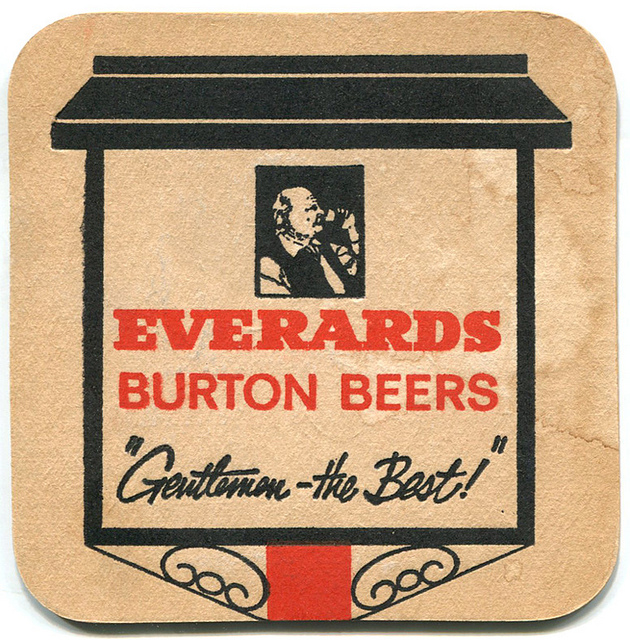 The Campaign for Real Ale (CAMRA) is a national voluntary organisation which campaigns for real ale, community pubs, and consumer rights; the members of its Leicester Branch keep a keen eye on the region’s pubs.
The Campaign for Real Ale (CAMRA) is a national voluntary organisation which campaigns for real ale, community pubs, and consumer rights; the members of its Leicester Branch keep a keen eye on the region’s pubs.
Delegates who have been lucky enough to get tickets for the now sold-out Guildhall Reception will have the chance to sample local ales, alongside local delicacies such as Melton Mowbray pork pies, Stilton cheese, and Leicester’s Indian cuisine; but if you are still looking for something to do on the evening of Thursday 10th January, do not despair! We will be holding a free pub quiz (sponsored by Antiquity), with a mystery prize for the winning team. Further details will follow…





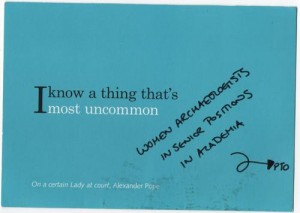
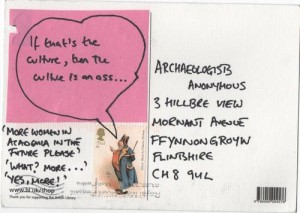
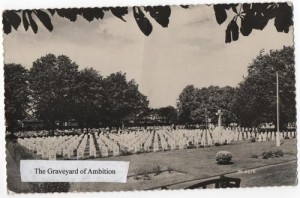
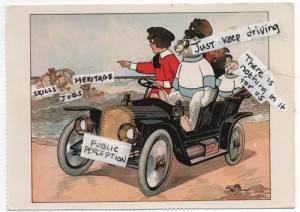
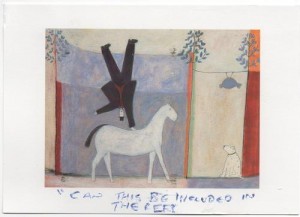
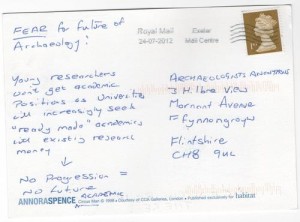
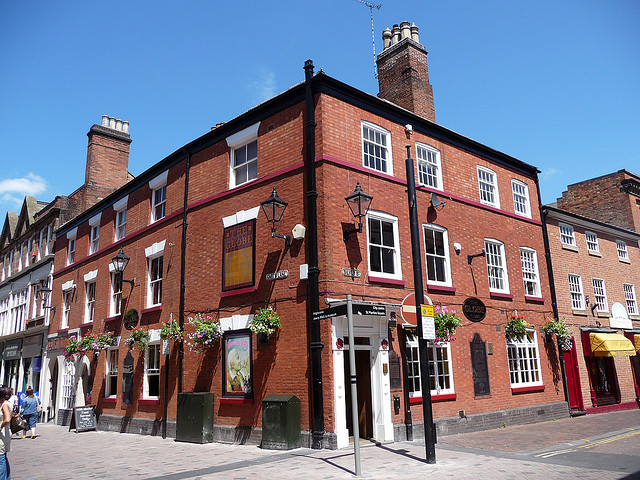


Pingback: WAC May 2012 eNewsletter – Volume 40 – World Archaeology Congress